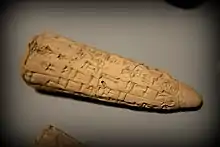Enlil-bani
Enlil-bāni,[nb 1] ca. 1798 BC – 1775 BC (short chronology) or 1860 – 1837 BC (middle chronology), was the 10th king of the 1st Dynasty of Isin and reigned 24 years according to the Ur-Isin kinglist.[i 1] He is best known for the legendary and perhaps apocryphal manner of his ascendancy.
| Enlil-bāni | |
|---|---|
| King of Isin | |
 Foundation Cone of Enlil-Bani. | |
| Reign | ca. 1798 BC – 1775 BC |
| Predecessor | Erra-imittī |
| Successor | Zambiya |
| House | 1st Dynasty of Isin |
Biography
A certain Ikūn-pî-Ištar[nb 2] is recorded as having ruled for 6 months or a year, between the reigns of Erra-imittī and Enlil-bāni according to two variant copies of a chronicle.[1] Another chronicle[i 2] which might have shed further light on his origins is too broken to translate. A lengthy inscription proclaims:
In Nippur I established justice, and promoted righteousness. I sought out nourishment for them like sheep, and fed them with fresh grass. I removed the heavy yoke from their necks and settled them down in a firm place. Having established justice in Nippur and made their hearts content, I established justice and righteousness in Isin and made the heart of the land content. I reduced the barley-tax, which had been at one-fifth, to one-tenth. The muškēnum[nb 3] served only four days in the month. The livestock of the palace had grazed on the fields of … who had cried out with the appeal, “O Šamaš” - I turned the palace livestock out of their ploughed fields and banished those people’s cries of “O Šamaš.”[2]
— Enlil-bāni Inscription, CBS 13909[i 3]
Hegemony over Nippur was fleeting, with control of the city passing back and forth between Isin and Larsa several times. Uruk, too, seceded during his reign and, as his power crumbled, he may have had the Chronicle of Early Kings[i 4] redacted to provide a more legendary tale of his accession than the rather mundane act of usurpation that it may well have been.[1] It relates that Erra-Imittī selected his gardener, Enlil-bâni, enthroned him, and placed the royal tiara on his head. Erra-Imittī then died while eating hot porridge, and Enlil-bâni by virtue of his refusal to quit the throne, became king.[3]
The colophon of a medical text,[i 5] “when a man's brain contains fire,”[nb 4] from the Library of Ashurbanipal reads: “Proven and tested salves and poultices, fit for use, according to the old sages from before the flood[nb 5] from Šuruppak, which Enlil-muballiṭ, sage (apkallu) of Nippur, left (to posterity) in the second year of Enlil-bāni.”[4][5][6]
Enlil-bāni found it necessary to "build anew the wall of Isin which had become dilapidated,"[i 6] which he recorded on commemorative cones. He named the wall Enlil-bāni-išdam-kīn,[i 7] “Enlil-bāni is firm as to foundation.” In practice, the walls of major cities were probably under continuous repair. He was a prodigious builder, responsible for the construction of the é-ur-gi7-ra, “the dog house,”[i 8] temple of Ninisina, a palace,[i 9] also the é-ní-dúb-bu, “house of relaxation,” for the goddess Nintinugga, “lady who revives the dead,”[i 10] the é-dim-gal-an-na, “house - great mast of heaven,”[i 11] for the tutelary deity of Šuruppak, the goddess Sud, and finally, the é-ki-ág-gá-ni for Ninibgal, the “lady with patient mercy who loves ex-votos, who heeds prayers and entreaties, his shining mother.”[i 12][7] Two large copper statues were taken to Nippur for dedication to Ningal, which Iddin-Dagān had fashioned 117 years earlier but had been unable to deliver, “on account of this, the goddess Ninlil had the god Enlil lengthen the life span of Enlil-Bāni.”[i 13][8] He is recorded, in two foundation nails, as having built (or possibly rebuilt) a temple to the goddess Annunitum.[9]
There are perhaps two hymns addressed to this monarch.
Inscriptions
- Ur-Isin kinglist line 15.
- The Babylonian chronicle fragment 1 B ii 1-8.
- CBS 13909 in the University Museum, Philadelphia.
- Chronicle of early kings A 31-36, B 1-7.
- Tablet K.4023 column iv lines 21 to 25.
- Cones IM 77922, CBS 16200, and 8 others.
- Two cones, IM 10789 and UCLM 94791.
- Cone 74.4.9.249 and another in a private collection in Wiesbaden.
- Clay impression, IM 25874.
- Cone in Chicago A 7555.
- IM 79940.
- NBC 8955 and A 7461 inscription on two cones.
- Tablet UM L-29-578.
Notes
- Inscribed dEn-líl-dù or dEn-líl-ba-ni.
- I-k[u-un]-pi-Iš8-tár.
- The muškēnum were a class between freemen and slaves.
- Enuma amelu muḫḫu-šu išata u-kal.
- (21) [na]p-šá-la-tú tak-ṣi-ra-nu lat-ku-tu4 ba-ru-ti šá ana [Š]u šu-ṣú-ú (22) šá KA NUN.ME.MEŠ-e la-bi-ru-ti šá la-am A.MÁ.URU5(abūbi) (23) šá ana LAMXKURki(šuruppak) MU.2.KÁM IdEN.LĺL-ba-ni LUGAL uruÌ.ŠI.INki (24) IdEN.LĺL-mu-bal-liṭ NUN.ME NIBRUki [ez]-bu.
References
- Jean-Jacques Glassner (2005). Mesopotamian Chronicles. SBL. pp. 107–108, 154. Glassner’s manuscript’s C and D.
- J. N. Postgate (1994). Early Mesopotamia: society and economy at the dawn of history. Routledge. p. 239.
- Simo Parpola (2009). Letters from Assyrian Scholars to the Kings Esarhaddon and Assurbanipal: Commentary and Appendix No. 2. Eisenbrauns. p. XXVI.
- Alan Lenzi (2008). "The Uruk List of Kings and Sages and Late Mesopotamian Scholarship". Journal of Ancient Near Eastern Religions. 8 (2): 150. doi:10.1163/156921208786611764.
- William W Hallo (2009). The World's Oldest Literature: Studies in Sumerian Belles Lettres. Brill. p. 703.
- R. Campbell Thompson (1923). Assyrian medical texts from the originals in the British Museum. Oxford University Press. pp. iii, 104–105. for line art.
- A. Livingstone (1988). "The Isin "Dog House" Revisited". Journal of Cuneiform Studies. 40 (1): 54–60. doi:10.2307/1359707.
- Douglas Frayne (1990). Old Babylonian period (2003-1595 BC): Early Periods, Volume 4 (RIM The Royal Inscriptions of Mesopotamia). University of Toronto Press. pp. 77–90.
- Sánchez Muñoz, Daniel, "A Sumerian Royal Inscription Describing the (Re) Building of a Chapel for Annunītum by King Enlil-Bāni of Isin", Archiv orientální 91.1, pp. 1-17, 2023